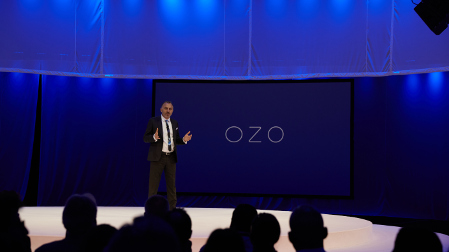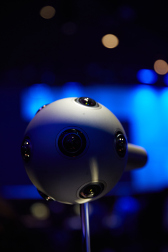Nokia Demos Live VR With Music Broadcast
LOS ANGELES—At a recent press event Nokia Technologies unveiled OZO, which the company describes as the first virtual reality camera aimed at professional use. The $60,000 camera, which is slated to ship in the first quarter of 2016, is smaller than a human head, weighs less than 10 pounds and is outfitted with eight synchronized, progressive scan with global shutter 2Kx2K camera sensors and eight microphones. Video is 30 frames per second, and the OZO is wireless and can be controlled remotely.

Nokia Technologies’ President Ramzi Haidamus introduces the company’s OZO VR camera
What Nokia Technologies President Ramzi Haidamus really wants you to know about OZO is that it’s the first VR camera to provide 360-degree live streaming, as well as the first to offer a simultaneous lower-res stream for monitoring. “Live monitoring was essential,” he said. “It’s a pain point for filmmakers and there isn’t a single VR camera that could do that.”
LIVE STREAMING VR
To show off these features, Nokia Technologies, with the help of partners Capitol Records and Akamai, live-streamed a performance by the band Best Coast from the roof of Capitol Record’s iconic Hollywood building to the Los Angeles Live Event space in downtown. “We could have moved the VR signal to New York,” notes Akamai Chief Architect Will Law. He reports that the biggest challenge for the demo was the bitrate, but that the VR footage, “approaches 4K UHD” in terms of bandwidth. “We’re used to distributing UHD today,” he says. In fact, most experts points out that VR video distribution will “piggyback” on the system upgrades driven by the 4K/UHD rollout.
OZO is intended to strip away some of the complications of making virtual reality, said Nokia Technologies CTO Dr. Guido Jouret. That’s why it records to a removable digital cartridge, which records 45 minutes, rather than numerous SD cards and why the stitching of images is automatic in live streaming. Post production (which requires stitching) relies on a suite of tools familiar to filmmakers, from Adobe Premiere to Blackmagic Design Resolve. Nokia also offers a free app, OZO Creator, to allow video to be transcoded and viewed on a Mac Pro 6-Core Dual GPU.

The $60,000 OZO VR camera is smaller than a human head, weighs less than 10 pounds and is outfitted with eight synchronized, progressive scan with global shutter 2Kx2K camera sensors and eight microphones.
Haidamus also made it clear that Nokia Technologies has no intent to distribute content, become a content aggregator or make a head-mounted display. “Our initial role in this ecosystem is to provide the capture solution,” he says.
Hardie Tankersley, senior vice president of innovation at Fox, which won the first VR Emmy for its “Sleepy Hollow” experience, described the OZO as “super interesting.”
The professional video industry's #1 source for news, trends and product and tech information. Sign up below.
“We do need camera technologies,” he said. “And I love an all-in-one unit."
Tankersley has issues with current VR camera technology. “It’s tricky to shoot with a ball of GoPros,” he said. “It’s difficult to preview an image, they have finicky Bluetooth connections and if one of them is low on batteries, it starts beeping. So it makes sense to have an integrated, customized camera.”
THE VALUE OF 3D EXPERIENCE (AND CONTENT)
SuperData Research, which analyzes the gaming and playable media market, has predicted that virtual reality will be a $15 billion market by the end of 2017. Whereas gaming is a no-brainer application for virtual reality, the studios—witness VR content for “Sleepy Hollow” and “Wild”—are also intrigued, as are several film/TV filmmakers. A sizeable trickle of former VFX and 3D experts have made their way into the VR space; former Digital Domain chief executive Cliff Plumer, for example, now heads up Jaunt Studios, which makes VR content.
Steve Schklair, who made his career in 3D, notes the overlapping skillsets. “3D experts have gone through a technology shift that taught them to deal with multiple images,” he said. “VR is nothing more than multiple images, so it’s the most logical extension of skillsets.” He worked on two VR videos for Nokia using the alpha version of OZO, he reveals, and has worked with other VR production companies and is currently co-producing, with director/writer Randal Kleiser, the 11-part episodic VR series “Defrost.”
Having ridden the 3D wave, Schklair is justifiably wary about VR. “The thing that scares me the most is bad content,” he says. “People who’ve never seen VR might say, ‘why would I want to watch that?’ And then it would take them a long time to get them back. The business really needs good content, and quickly, to outweigh the not-so-good content.” He further notes that, although games and VR are a good match, no one really knows about the prospects of “cinematics and VR.”
WHAT’S THE ‘SWEET SPOT’?
At the Entertainment Technology Center at USC, Philip Lelyveld, program manager for the think tank’s VR/AR initiative, notes that the biggest trend in the last year has been the release of the first wave of consumer products. “Samsung Gear VR was sold out on Amazon and Best Buy,” he notes. Another trend noted is that advertising firms are beginning to build VR into their marketing mix.
In the professional space, he believes that the effort will be “to find the price point and determine who pays—consumers, advertisers, backers.” Lelyveld points to inroads that VR has made in journalism (
The New York Times with its Google Cardboard series on refugees and ABC News’ VR reports from Syria); sports (NHL, NBA and Olympics) and music videos, mainly by small bands using GoPro rigs. “This may be the year where we see how the various ways of experiencing VR are adopted by the marketplace,” he notes.
Tankersley reports that Fox is busy at work on more 360-videos. “We’re doing a new 360-video every week,” he says. “We just launched with ‘Scream Queens’ where we go behind the scenes. We have videos on Facebook 360, YouTube and other places, available and live now.” But he notes the difference between 360-degree immersive videos and full-on virtual reality. “360 video isn’t a game changer,” he says. “I think the biggest distinction is head tracking. We’re trying to trick the viewer into thinking he’s really there, a truly immersive experience. And, today, that takes relatively high-end hardware and a dedicated space.”
At SMPTE, AMD Chief Technologist Layla Mah reported that achieving that level of true VR will take a paradigm of development that exceeds Moore’s Law. Lots of people and lots of money are trying to prove her wrong. But the outcome is still very much up in the air. “The big picture is,” says Tankersley, “that we’re still on the verge of something big. But that verge could last for years.”
